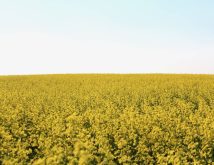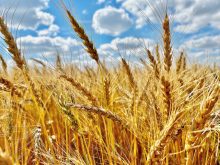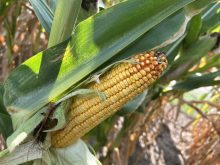A major agronomic announcement at Ag in Motion 2024 was the introduction and naming of a new sawfly and midge tolerant Canadian Western Red Spring wheat: AAC Oakman VB.
The variety still has two years of propagation ahead, but distributor SeCan expects it to hit the commercial market in 2026.
Why it matters: The new wheat variety was one of several dozen product and service launches at Western Canada’s largest outdoor farm show this July in Saskatchewan.
Read Also

Manitoba boosts stake in cereals centre to $23.5 million
Premier Wab Kinew said the additional project funds will help ‘Trump-proof’ the provincial economy.
Wheat stem sawfly hasn’t been the bane in 2024 that it was for the western Prairies in other years, and entomologists earlier this year worried that Manitoba might see a resurgence of wheat midge because of persistent rains.
The new solid-stem variety will be ready for the pressure, said Todd Hyra, western business manager for SeCan.
“It’s been a while since we’ve had anything like that in terms of that part of our toolbox to manage those insects,” he said.
AAC Oakman is rated intermediate for fusarium head blight resistance and scored 4.4 out of five for its pith wall, which Hyra described as “better than all of the older solid-stem checks.”
“It has solid stem. It has midge tolerance on board. (It’s) short, strong, really no agronomic penalties. That’s always exciting when you’ve got a variety that provides those protections but no baggage in terms of weaknesses.”
Adding sawfly to the label
The solid-stem variety beats sawfly by making itself an inhospitable habitat for larvae. In an uninterrupted life cycle, the female sawfly lays eggs in the stem of a plant. Females can lay 30 to 50 eggs in their lifetimes, but usually only one per stem.
Once eggs hatch, larvae burrow along the plant stem until they reach the bottom of the stalk, where they cut a v-shaped notch, weakening the stem and usually causing the plant to fall over.
Pith wall thickness plays a major role in sawfly resistance. The thicker the wall, the harder it is for the larvae to move.
“It makes it difficult for the larvae to burrow up and down. The stem slows them down and weakens them to the point where they don’t overwinter as well and they die off.
“They still get in there. They still lay. They may survive, but they’re not going to thrive the way they would in a typical hollow-stem variety.”
Developing Oakman
AAC Oakman has been somewhat of a surprise even to SeCan. Naturally bred insect tolerance is rare, said Hyra.
“The crosses were made with midge tolerant varieties and solid-stem varieties to generate it, but getting them all into one place is kind of amazing.”
Yield-wise, Hyra compared Oakman’s performance to long-time favourite AAC Brandon.
“I think it’s 98 per cent of AAC Brandon: short, strong straw, solid stem and good solid stem expression, which will help manage the sawfly. And it is also midge tolerant … as we’re seeing this year, there’s a lot of midge pressure out there.”
More resistance
On the Canadian Western Amber Durum front, SeCan had two solid-stem sawfly tolerant varieties on display at AIM: AAC Grainland and AAC Stronghold. Both are milling-quality durums.
Grainland’s strengths, as described in SeCan marketing materials, include a 10 per cent higher yield and similar height compared to its check, AC Strongfield. It also sports a resistant rating to common bunt, loose smut and leaf and stripe rust, as well as moderate resistance to stem rust. It’s noted for its low grain cadmium.
An older variety registered in 2016, Stronghold is similar in many respects, featuring five per cent higher yield than Strongfield, strength and resistance to leaf and stem rust as well as loose smut rust. It also features low cadmium.
“They’re established and available on a broad scale,” said Hyra.
Cordon Geisam, FP Genetics’ western Saskatchewan and southeast Alberta territory manager, said sawfly has been an issue throughout the Prairies over the past three years but — thanks to spring rains — has moderated outside of its traditional trouble spot in Palliser’s Triangle.
“We were finding a lot of sawfly damage outside the Palliser Triangle,” he said. “That’s where the challenges came from. It was strange because this incidence of sawfly was far away more widespread than previously known to be.”
Sawfly damage can be easily misdiagnosed, said Geisam. The key is opening the plant stem and looking for larvae. Otherwise, it can be mistaken for a dry season root rot, which “pinches the plant off at the soil level and the plant falls over. And people call it sawfly, but it’s not,” he said.
Today, FP Genetics’ go-to sawfly tolerant CWRS is CDC Adamant, which also includes tolerance to orange blossom wheat midge. A follow-up to FP Genetics’ long-serving, sawfly tolerant AC Lillian, which was declassified due to an unstable falling number, CDC Adamant has 40 per cent pith wall thickness compared to Lillian’s 60 per cent. Geisam said this thickness is dependent on environmental conditions.
Although classified at its time of registration as a solid-stem variety, it has since been reclassified as a semi-solid stem.
Geisam considers CDC Adamant, released commercially in 2019, to be a strong player in the sawfly tolerance market. Like AAC Oakman, it’s considered intermediately resistant to fusarium head blight.
“Not the highest but it’s right up there,” he said. “It’s good on its broad range disease list.”
CDC Adamant is rated resistant to stem rust and intermediate for leaf rust and also yielded above its check, he noted.
Geisam said farmers will benefit from efforts to “stack” resistant genes.
“It’s just a testament to the local — what I call local as in Western Canada — breeding through AAFC and CDC that gives us solutions for our western Canadian challenges.”
















